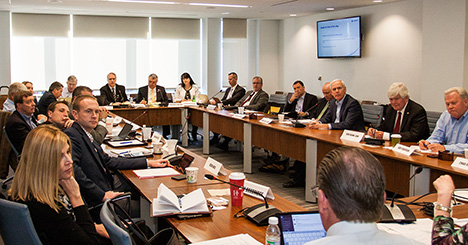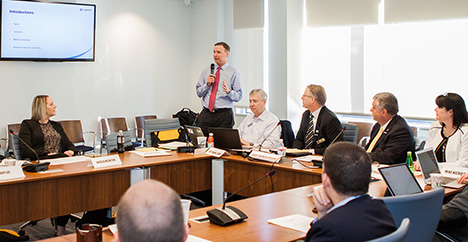
December 4, 2017
As the industry grapples with the best way to address current and future staffing shortages, more than 25 representatives of business aviation organizations recently met at NBAA’s Washington, DC headquarters to discuss ways that industry stakeholders can confront these issues, particularly for pilots, maintenance technicians and flight attendants.
During the NBAA Business Aviation Management Committee’s (BAMC) inaugural Workforce Summit on Nov. 30, possible solutions ranged from adjusting minimum-hour recommendations for pilots and expanding business aviation career promotion efforts in high schools and colleges to doing more to highlight the opportunities for higher quality of life within the industry.
After an opening message from NBAA President and CEO Ed Bolen, the early portion of the meeting was spent reviewing the results of NBAA’s 2017 survey of more than 1,300 business aviation pilots – the results of which paint a stark picture of the industry’s risk of losing qualified personnel.
“There’s been a change in paradigm – this isn’t the old aviation industry,” said Dr. Chris Broyhill, CAM, BAMC member and author of the workforce study. “The difference is the rate at which the airlines are expanding.”

Survey responses show that younger and mid-career pilots (those in their 20s, 30s and early 40s) are particularly receptive to airline recruiting efforts. The consensus among summit participants was that the issue would only be exacerbated, as the airlines continue to ramp up hiring to meet projected commercial-pilot demand.
“We agree that this is not a bubble, and that this is a real issue we’ll be dealing with for at least the next decade,” said BAMC Chair Jad Donaldson, director of aviation for Harley-Davidson.
One response discussed is adjusting the minimum number of hours recommended in NBAA’s industry-standard Management Guide for business aircraft pilots to make it easier for qualified young aviators to begin getting hands-on experience earlier in their careers. This proposal was met with enthusiasm, though all parties cautioned that safety must always remain the critical factor when determining pilot readiness.
Other strategies discussed during the summit focused on expanding recruiting and awareness efforts to younger generations. One case study highlighted the successful collaboration between Michigan’s regional group, business aviation companies and area colleges, which has produced a steady stream of qualified personnel for companies in the state through early-age recruiting and annual scholarships. Read more about the Michigan Business Aviation Association’s scholarship program.
Summit participants also agreed that stakeholders need to do a better job communicating the industry’s quality-of-life benefits, including a more personal workplace environment, fewer nights away from home, and the flexibility that individual organizations have to offer competitive benefits such as loss of pilot medical certificate insurance.
BAMC plans to continue its discussions on this crucial industry issue. NBAA soon will be covering workforce issues in more depth in the January/February 2018 issue of Business Aviation Insider magazine.
Share your feedback on the workforce topic with NBAA at feedback@nbaa.org.


 International Business Aviation Council Ltd.
International Business Aviation Council Ltd.